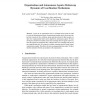1380 search results - page 30 / 276 » Reasoning about Input-Output Modeling of Dynamical Systems |
AAAI
2000
13 years 9 months ago
2000
Certain problems in connection with, for example, cooperating agents and distributed systems require reasoning about time which is measured on incomparable or unsynchronized time ...
ATAL
2008
Springer
13 years 8 months ago
2008
Springer
Agents in an organization need to coordinate their actions in order to reach the organizational goals. Organizational models specify the desired behaviour in terms of roles, relati...
JSS
2007
13 years 7 months ago
2007
Large systems often have a long life-span and comprise many intricately related elements. The verification and maintenance of these systems require a good understanding of their ...
FUIN
2006
13 years 7 months ago
2006
This paper introduces an approach to behavioral pattern identification as a part of a study of temporal patterns in complex dynamical systems. Rough set theory introduced by Zdzisl...
ECMDAFA
2006
Springer
13 years 11 months ago
2006
Springer
Abstract. The Unified Modelling Language (UML) is intended to describe systems, but it is not clear what systems satisfy a given collection of UML diagrams. Stephen Mellor has desc...


